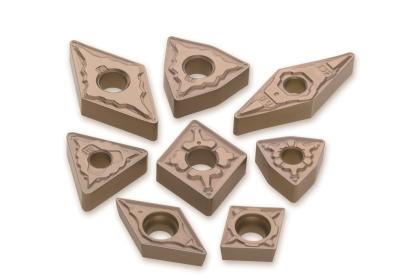
Tungaloy’s new T9225 insert grade is joining the earlier successes of T9125 to complement the T9200 CVD grade series for steel turning. T9225 brings an exceptional combination of unparalleled wear resistance and top-notch edge toughness of all P25 grades available on the market to every steel turning application.
These properties of T9225 are attained by three primary technologies, including: extremely wear resistant Al2O3 coating in a thick and uniformly aligned layer, ultrahard ceramics for the outermost layer and PremiumTec – Tungaloy’s exclusive post surface treatment technology.
These make T9225 a versatile steel turning grade effective in a wide range of applications, ensuring long tool life and stable performance for improved productivity.
In combination with proven T9215 grade, T9225 joins the T9200 series to cover various steel turning needs.
The range of T9225 includes the -TSF, -TM, and -TH chipbreakers: the first choice for steel turning in standard ISO inserts as well as successful ISO-EcoTurn inserts. A total of 349 inserts are introduced in T9225 to cover a wide range of applications.
At a Glance:
Thick and uniformed crystal growth Al2O3 layer for impressive wear resistance
Ultrahard ceramic layer with 1.5x hardness for improved wear resistance
PremiumTec post surface treatment technology for stable machining
Contact Details
Related Glossary Terms
- ceramics
ceramics
Cutting tool materials based on aluminum oxide and silicon nitride. Ceramic tools can withstand higher cutting speeds than cemented carbide tools when machining hardened steels, cast irons and high-temperature alloys.
- chemical vapor deposition ( CVD)
chemical vapor deposition ( CVD)
High-temperature (1,000° C or higher), atmosphere-controlled process in which a chemical reaction is induced for the purpose of depositing a coating 2µm to 12µm thick on a tool’s surface. See coated tools; PVD, physical vapor deposition.
- hardness
hardness
Hardness is a measure of the resistance of a material to surface indentation or abrasion. There is no absolute scale for hardness. In order to express hardness quantitatively, each type of test has its own scale, which defines hardness. Indentation hardness obtained through static methods is measured by Brinell, Rockwell, Vickers and Knoop tests. Hardness without indentation is measured by a dynamic method, known as the Scleroscope test.
- turning
turning
Workpiece is held in a chuck, mounted on a face plate or secured between centers and rotated while a cutting tool, normally a single-point tool, is fed into it along its periphery or across its end or face. Takes the form of straight turning (cutting along the periphery of the workpiece); taper turning (creating a taper); step turning (turning different-size diameters on the same work); chamfering (beveling an edge or shoulder); facing (cutting on an end); turning threads (usually external but can be internal); roughing (high-volume metal removal); and finishing (final light cuts). Performed on lathes, turning centers, chucking machines, automatic screw machines and similar machines.
- wear resistance
wear resistance
Ability of the tool to withstand stresses that cause it to wear during cutting; an attribute linked to alloy composition, base material, thermal conditions, type of tooling and operation and other variables.

